The Compact Loader Alternative
On the wide-ranging construction sites of North America, the skid steer has long ruled urban project sites. Its size, versatility, maneuverability and price have given the skid steer an affordable and adaptable edge in multiple markets (farming, construction, landscape, municipal work, rental, private use and onward). Not to mention, it’s a great American invention, engineered out of the venerated Ag industry of North Dakota.
But just because a machine is popular doesn’t necessarily make the skid steer the right machine to rent or purchase for a professional operation. When it comes to compact styles of loaders, there are many choices — compact tool carriers (those walk-behind or stand-on units), compact track loaders (those skid steers on tracks) and perhaps the most underrated machine in the U.S. compact market — the compact wheel loader — which is superior in many ways to the skid steer.

“Customers appreciate the added visibility and articulated steering, which offers minimal ground disturbances,” says Kelly Moore, product manager and training specialist for Gehl. “There are untold applications for compact wheel loaders in landscape contracting work, tree and tree service work, municipal and institutional locations for grounds work, rural cooperatives with feed/fertilizer services, ranch and horse operations, small- to mid-sized farm operations and many more. Many buyers of compact wheel loaders already own and operate skid steer loaders. They invest in a wheel loader to supplement the advantages the loader offers in those applications where the compact wheel loader excels over a skid steer.”
The price of compact wheel loaders is fairly far and wide as there are a variety of units on the market, which can range from $30,000 to $100,000 (though most fall in the $50,000 to $60,000 price category). When compared to a skid steer, which ranges from $20,000 to $50,000, that’s a significant sticker shock. The purchase price may be higher, however, the total cost of ownership should be considered — that’s the small wheel loader pitch. A compact wheel loader will provide many benefits, including a longer ownership period, lower owning and operating costs and greater productivity when compared to a skid steer in lots of applications.
To help you better understand the wealth of machine options in the market, we asked manufacturers from Kubota to Case to submit a summary of their compact wheel loader lines. What we found was a huge variety of machines (especially compared to the amount of units being purchased — only about 2,000 to 3,000 units are sold per year in North America). That’s because compact wheel loaders are more popular in Europe, but their acceptance is growing more and more in America. If you’re interested in this upcoming machine market, read the manufacturer summaries on the next seven pages.
Keith Gribbins is managing editor of Compact Equipment, based in Peninsula, Ohio.
Kawasaki Compact Wheel Loaders
By Sam Shelton, Marketing Administrator
Kawasaki recently introduced two new wheel loader models into the compact loader market. The new Kawasaki models, the 42ZV-2 (a 0.78-cu yd loader) and the 45ZV-2 (a 1.18-cu yd loader) are designed and engineered with all of the performance and reliability of the larger Kawasaki wheel loaders, but in a smaller package. With standard features such as a hydraulic quick-coupler, third spool hydraulics and reliable Kubota engines, these loaders are small in size but big in value.
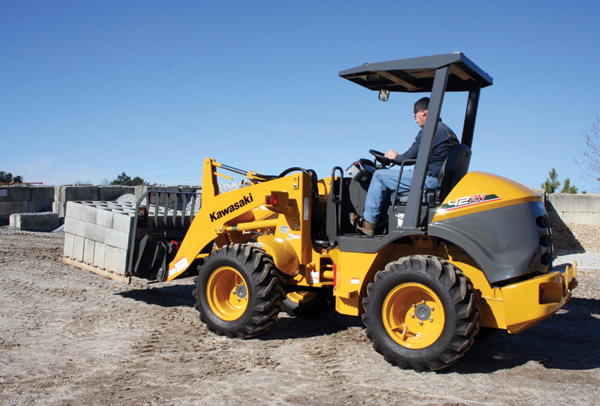
With Tier IV Interim emissions-compliant engines, heavy box frames and a well balanced design, these compact Kawasaki wheel loaders provide stable, reliable operation. Innovative HN bushing technology, easy access electrical relays and the side-by-side aluminum radiator and oil cooler provide easy access for maintenance. From the walk-through cab design to the easy-read monitors, this is an operator-friendly wheel loader. With a rubber-mounted cab engineered to reduce noise and vibration and pillar-less full length windows, this is one comfortable, efficient working environment.
Overall you will find these loaders to be responsive and fast. With one of the quickest ground speeds in its class, the 45ZV-2 features an electronically controlled hydrostatic powertrain providing quick, smooth acceleration. The wrap-around counterweight allows for a very stable, well balanced loader. Kawasaki is the oldest ongoing manufacturer of rubber-tire, articulated wheel loaders in the world, serving the North American market for more than 30 years. For more information, visit www.kawasakiloaders.com.
Wacker Neuson Compact Wheel Loaders
By Marcus Auerbach, Director of Compact Equipment
Wacker Neuson’s history with wheel loaders goes back more than 80 years. Today, the company is the largest global manufacturers of compact wheel loaders, when combining its three brands — Wacker Neuson (North America) and Weidemann and Kramer Allrad (offered in Europe). In 2008, Wacker Neuson successfully launched articulated and all-wheel-steer models to the North American market.

A number of adjustments have been made to adapt the wheel loaders to the special requirements of the North American market which tends to be very attachment driven. Wacker Neuson engineers have outfitted the units with universal skid steer attachment plates, which make the compact wheel loaders much more versatile tool carriers. They have also increased the hydraulic flow (up to 33 gpm on the WL 37) and have added electrical attachment controls. Equipped like this, a compact wheel loader can handle anything from a broom to a snow blower or even a cold planer. The big advantage of the wheel loaders in general is up to 30 percent fuel savings and up to 75 percent in tire savings when compared to a skid steer loader.
Wacker Neuson is the only manufacturer to offer both articulated and all-wheel-steer wheel loaders for a total of nine units in the fleet. The most popular articulated machines are the WL 30 and the WL 37. The articulated machines are very maneuverable in confined areas and can bend around corners while the machine follows the path of the attachment. The best-selling WL 30 is compact enough to fit on tight jobs, and when equipped with a narrow wheel kit, it can fit on a 48-in. sidewalk for snow removal with a blower in the front and a salt spreader in the back, providing a one-pass process.
The WL 37 is a bit beefier and comes with a 75-hp engine, which allows up to 33 gpm true high flow, making the machine ideal for large snow blowers, cold planers or stump grinders. The WL 37 has also a little bit more payload and can handle even a soaking wet pallet of sod. The all-wheel-steer 280 is a small rigid frame loader which is great in rental due to its unmatched stability and ability to cross rough terrain.
Wacker Neuson believes the compact wheel loader market has a very bright future. It took about 10 years for mini excavators to catch on in North America because everyone thought of them as a toy, and today they are on every job. Compact wheel loaders have certain operating cost advantages over skid steer loaders, specifically in applications on hard surfaces because of the tire wear and because of better fuel efficiency. Competitive pressure forces contractors to constantly re-evaluate their approach, and many will find out that a wheel loader can get more done for less money in certain applications and thus provide a competitive advantage to the contractor. For more information, visit www.wackerneuson.com.
Gehl Compact Wheel Loaders
By Kelly Moore, Product Manager and Training Specialist
The Gehl brand originated in 1859 and entered into the compact loader industry in 2008 for European markets and in 2010 in North America. Early machines sold in Europe during the 1990s and 2000s were OEM models. Today, there are three models developed and manufactured in Gehl’s Yankton, S.D., plant which feature multiple variations and options to meet customer preferences. The 140 is a sub-compact with a 960-lb load capacity and narrow bucket width of 44 in. The 340 has a 1,890-lb load capacity and bucket width of 54 in., and the larger 540 model has a 2,560-lb load capacity and a bucket width of 60 in.
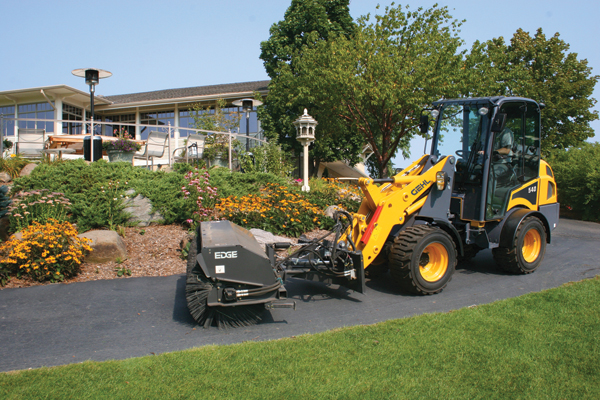
Each Gehl wheel loader has excellent visibility due to the operator position on the machine. With articulated steering, as opposed to skid steering, the wheel loader can readily maneuver jobsites without disturbing soil, turf or any ground surfaces. The hydrostatic, two-speed drive is standard on the models 340 and 540 with ground speeds faster than 12 mph. Each model is available as a basic economy two-post ROPS unit, four-post ROPS unit or fully enclosed cab unit. The models 340 and 540 have an additional full-featured cab option. Each model features differential lock as standard equipment and an “inching pedal” for ideal driving and power/speed control for precise control of attachments.
The market in North America for compact wheel loaders remains considerably lower than other compact loaders (skid steer and compact track loaders), as well as in other areas of the world, when compared to the larger numbers seen in Europe. It’s estimated 2011 saw 2,400 to 2,500 units sold. However, the percentage market increase in the past few years has been very positive on these types of units.
When purchasing, know all the types of jobs and applications you have had and would anticipate in future years with the investment of a new compact wheel loader. What space areas do you have for maneuvering with a loader? What attachments do you already have or rent on occasion that would readily work with a compact wheel loader? Gehl compact wheel loaders utilize the same universal quick-attach and hydraulic couplers as skid loaders. Ensure you see your local dealer with these points in mind and review a machine first-hand — test drive one to see and feel the visibility and maneuverability of the machine. Go over the unit’s features and specifications to ensure it will suit your application needs. Inquire about the dealer’s parts and service abilities and accessibility of these important after-sales support points by the dealership and manufacturer. For more information, visit www.gehl.com.
Kubota Compact Wheel Loaders
By Keith Rohrbacker, Product Manager
Kubota Tractor Corp. (KTC) entered the U.S. market in 1986 with the R400. Since then, Kubota has introduced several models in the R10 Series and R20 Series. The two main models today are the R420S, which has a 43-hp engine, half cu yd bucket and produces a maximum bucket breakout force of 6,550 lbs. The company also have the R520S, with a 49-hp engine, 3/4 cu yd bucket and breakout force of 7,425 lbs. Kubota’s R420S and R520S offer strength, comfort and superior operator benefits. Both models are powered by fuel efficient E-TVCS three- and four-cylinder Kubota diesel engines.
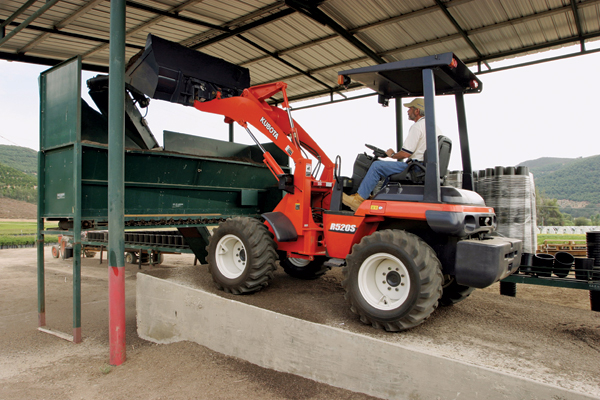
Compact wheel loaders overall are highly maneuverable in tight spaces, with 40 degrees of articulation and 8 degrees of frame oscillation. Four-wheel drive and limited-slip differential power the machines through rough terrain. Front and rear auxiliary hydraulic systems are standard, and a front valve and control lever are built-in to universally accept hydraulically operated attachments. Clutchless electric shuttle shifting allows for quick, smooth directional changes without the need to brake.
Kubota developed various new technologies for the R20 Series that resulted in a number of exciting features: a load-sensing transmission; rear frame oscillation with excellent stability; an articulated frame for reduced turning radius; and a powerful operating capacity covering a wide range of tasks Kubota participates in the less-than-60-hp compact wheel loader segment.
The most recent peak sales season in that class was about 1,280 units sold retail. Last year the under 60-hp segment market recovered to approximately 720 units. We think that the market will grow in the 10 to 15 percent range this year.
So select the size of the machine for your current applications and ensure that it is enough to satisfy your future growth. Choose a dealer that will support your product well. Specific to wheel loaders, consider that the price may be higher than the typical skid steer loader, but the versatility of auxiliary hydraulics to operate multiple attachments, the lower fuel consumption, lower operating costs (especially tires), improved visibility and ease of operation will provide benefits and productivity above and beyond those of a skid steer loader over the long haul.
Most of Kubota’s wheel loader sales go to nurseries and landscapers. Nurseries use the loaders to unload their wares and move them around the facility. Then when landscapers come shopping the nurseries, they use them to load the trucks and trailers. Typical landscapers may use an auger on their wheel loaders to dig holes for trees, change over to a tree boom to unload the trailer and put the trees in the holes they just dug, then switch over to a bucket to bring in backfill soil and finish the job with bark or other ground cover. For more information, visit www.kubota.com.
John Deere Compact Wheel Loaders
By Doug Laufenberg, Product Marketing Manager
John Deere has been involved in the compact wheel loader market for more than 20 years. Although there have not been many major changes recently, operating capacities, operator interfaces, machine performance and horsepower have improved. In addition, today’s emissions standards are playing a role in machine development.
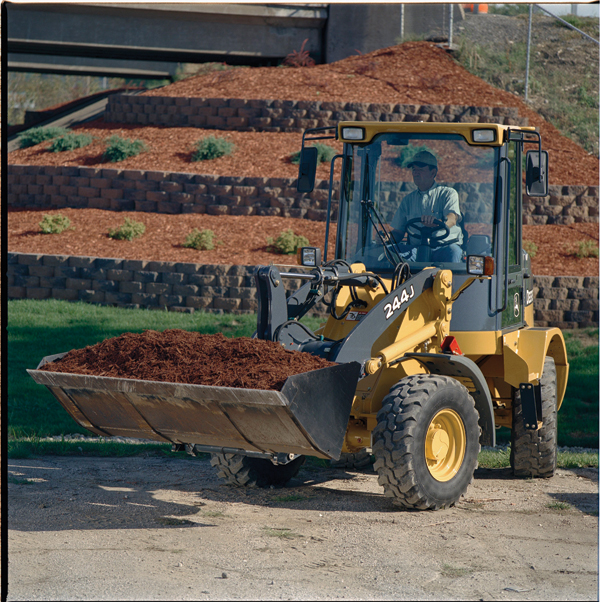
Here’s a quick summary of the J-Series of compact wheel loaders. The 244J has a 59-hp engine, full-turn tip load of 7,718 lbs, height to hinge pin of 10 ft, 6 in., operating weight of 11,552 lbs and an auxiliary hydraulic flow of 17 gpm. The 324J has 73 hp, full-turn tip load of 9,315 lbs, height to hinge pin of 11 ft, operating weight of 13,404 lbs and an auxiliary hydraulic flow of 25 gpm. The 344J has 97 hp, full-turn tip load of 12,522 lbs, height to hinge pin of 12 ft, operating weight of 18,761 lbs and an auxiliary hydraulic flow of 30 gpm.
John Deere compact wheel loaders feature the unique oscillating (frame and rear axle) stereo steering that delivers a turning radius that’s 20 percent tighter than comparable loaders. A top speed of 19 mph (the only manufacturer with top speed standard) allows contractors to move more materials quickly and efficiently. In addition, John Deere models allow the operator to upshift and downshift on the fly, with no need to stop and shift. John Deere models are also compatible with John Deere Worksite Pro Attachments, including pallet forks, snow pushers, pickup brooms, augers, utility blades, etc.
The most important piece of advice is to pick the right machine for the application at hand. Visit and speak with your local dealer and demo the model you are interested in on your jobsite. It’s also important to understand what the limitations are for the piece of equipment you are looking to buy. Are you operating in a tight area? Is turning radius and stability an issue? Is travel speed a concern? How about operator comfort and visibility? A customer should certainly ask themselves these questions when looking to purchase a compact wheel loader.
Compact wheel loaders are very popular with the landscape market. Installers, supply yards and tree growers all use the machines for various tasks. In the northern states, manufacturers are seeing more contractors using compact wheel loaders for snow removal. Building developers are also utilizing compact wheel loaders for their reach, lift height, maneuverability and the fact it doesn’t mark the ground when it turns. For more information, visit www.deere.com.
Terex Compact Wheel Loaders
By Jamie Wright, Product Manager
Terex wheel loaders were originally developed by German manufacturer Schaeff in 1971. Terex acquired Schaeff and took over the wheel loader line in 2002. Terex wheel loaders are manufactured in Crailsheim, Germany. Today, Terex compact wheel loaders range from 50 to 175 hp with bucket capacities between 0.65 and 6.0 cu yds and achieve breakout forces from 8,325 to 26,995 lbs.
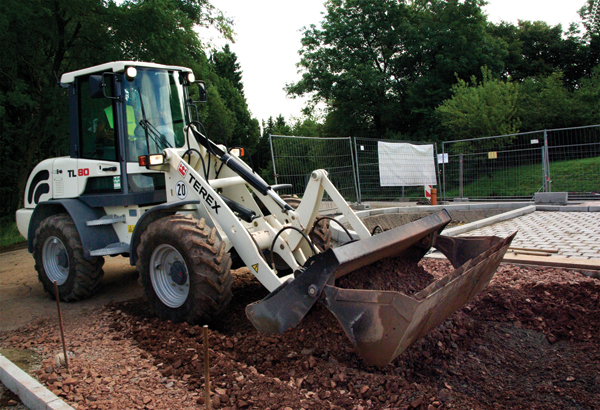
Terex compact wheel loaders offer economical, quiet and low-maintenance operation without sacrificing cutting-edge technology. Each model incorporates transverse-mounted engines, so Terex wheel loaders can lift and transport high payloads and in turn lower fuel consumption. Designed with an oscillating rear axle, they provide comfort and easy handling on rough terrain by maintaining four-wheel traction. In addition, they feature articulated steering to maneuver in tight spaces.
Operators can easily and accurately control movements even when giving the loader full power, making Terex hydrostatic wheel loaders the choice for powerful breakout and fast lifting. Terex compact wheel loaders come standard with a general purpose bucket. Terex also offers the following optional attachments for its compact wheel loader line: side-dump buckets; light material buckets; forks and carriers; brooms; multipurpose buckets; and jibs.
Terex introduced a high-flow auxiliary hydraulic option to the Terex TL80 and TL100 models, which allow an extended work application base with the use of continuous flow attachments. The larger models in the Terex compact wheel loader line are equipped with SP-kinematics that combine the advantages of Z-kinematics (power at the bucket) with those of P-kinematics (precise parallel handling of the bucket and loader equipment over the entire lifting height).
The wheel loader industry has been introducing the hydrostatic transmission to replace the traditional mechanical transmissions. This drive system provides a high power output per unit mass and has infinitely variable and step-less speed. In addition, up to 90 percent of the maximum torque is available at start-up. Hydrostatic drive transmissions provide a benefit here due to their high efficiency which contributes to reduced fuel consumption. Manufacturer tests have shown that fuel usage can be reduced up to 10 percent with the new hydrostatic drive systems compared to mechanical drive transmissions.
Again, the hydrostatic transmission is one of the biggest improvements to havwe been made in recent years. However, there is a new system that is even more efficient called the “hydrotransmatic system” that utilizes two piston hydraulic motors that work together to create a very efficient drive system. Both motors provide power to the transfer case when high torque requirements are needed. Only one motor is utilized when high speed is required. This two-motor system lowers fuel consumption compared to the conventional systems and is considered state-of-the-art for mid-range loaders. For more information, visit www.terex.com.
Case Compact Wheel Loaders
By Tim O’Brien, Brand Marketing Manager
Case introduced its D Series of compact wheel loaders in 2000. Initial models included the 21D, 221D and 321D. The company upgraded these to the E Series for Tier 2 in 2006 including the addition of the 121E, then to the E Series 3 for Tier 3.
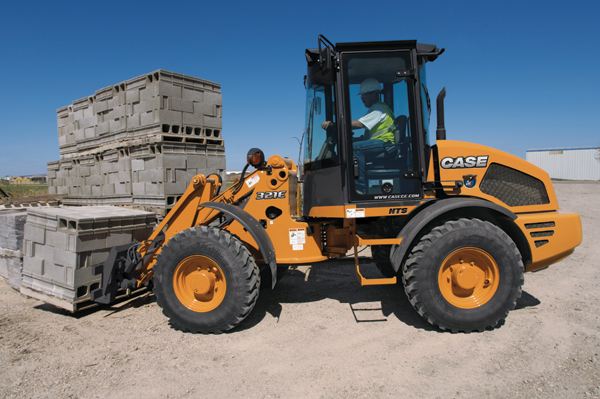
Case compact wheel loaders incorporate many features of its full-size wheel loaders, along with some unique compact wheel loader features to make smaller jobs more productive. High power-to-weight ratio (like other Case wheel loaders) delivers strong performance and productivity. Transverse-mounted engine enhances stability and allows for the short-sloped rear hood. Limited slip differentials provide high traction in all conditions. Full articulation results in superior maneuverability in tight spaces with predictable steering.
Two-speed hydrostatic drive with infinitely variable speed control is excellent for applications that demand low speed and high hydraulic flow to attachments. Case also offers an optional high speed version for the Case 121E Series 3 and larger models.
The full-size, high-visibility cab provides exceptional operator comfort. Versa-boom loader linkage offers a variety of benefits, including better reach, enhanced visibility to the tool, high breakout forces and parallel lift capability. And a universal fit coupler can accept a wide range of buckets and work tools, including most skid steer-compatible attachments.
Potential buyers should consider their applications and operators and compare to the smaller alternative (skid steer loaders) and the larger alternative (full-sized wheel loaders). Compact wheel loaders are best for higher production applications, such as frequent truck loadings that are too small and confined for larger wheel loaders. Transportability should also be considered. Skid steers are lighter and smaller for easier trailering, but compact wheel loaders are better for roading — to get to the job easily if within roading distance.
Equipping the machine with the proper options is key to getting your work done quickly and effectively. Options such as ride control and high speed should be considered if you need to road the machine from site to site. Compact wheel loaders, with their full-size comfortable cab, are popular for working in very hot or cold temperatures — and the optional cold weather package makes Case compact wheel loaders popular and productive for clearing snow and tackling other winter applications. For more information, visit www.casece.com.




